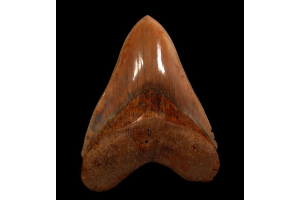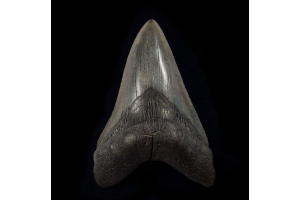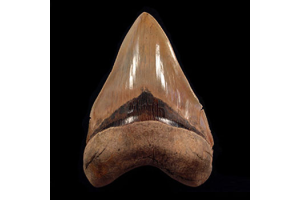Page 2 - Gary Greaser
- - December 04, 2025
The ocean’s most formidable predator — the Megalodon — roamed Earth’s ancient seas millions of years ago. Today, its legacy lives on in the form of massive fossilized teeth. At Buried Treasure Fossils, we specialize in offering authentic, high-quality Megalodon teeth for collectors, enthusiasts, and anyone fascinated by prehistoric marine life. Among our most striking finds is a large, gray-colored Megalodon tooth from South Carolina — a spike-like lower anterior specimen featuring good quality enamel and an extra-large black bourlette. With fair but worn serrations and a complete root showing minimal hydration cracks, this tooth is 100 percent natural with no repair or restoration. It's an impressive addition to any collection.
If you're wondering where I can find Megalodon teeth in Florida, or elsewhere, you’re not alone. This question reflects a growing interest in discovering and owning pieces of natural history. With our extensive catalog from renowned fossil-rich localities, we make
- - December 04, 2025
For fossil collectors and enthusiasts, few discoveries inspire awe like a megalodon tooth. These relics from the world’s largest known shark species offer more than just a glimpse into prehistoric life; they hold layered evidence of ancient ecosystems and shark biology. As we’ve learned through years of fossil study, one of the most overlooked yet fascinating features is something known as megalodon tooth ledges. These natural ridges carry critical information about the shark’s life cycle, feeding habits, and even how the fossil was preserved.
Let’s take a closer look at what these ledges mean, how to read them correctly, and why they matter, whether you're a seasoned collector or just starting your fossil journey.
What Are Megalodon Tooth Ledges?
Tooth ledges are naturally occurring ridges or indentations visible along the enamel and root junction of a megalodon tooth. They often appear as horizontal, shelf-like lines and can easily be mistaken for damage or unnatural wear by less experienced
- - December 04, 2025
When we talk about the ocean’s most fearsome predators, the megalodon always comes to mind. This prehistoric giant shark lived millions of years ago and left behind fossils that continue to amaze scientists and collectors. Among its most prized remnants are its massive teeth, which raise an intriguing question: how big was the megalodon tooth, and could it be the largest tooth ever found in history?
At Buried Treasure Fossils, we’ve spent years helping collectors and enthusiasts connect with some of Earth’s most incredible remnants from the deep past. One of the most captivating of these is the megalodon tooth found in various locations around the world. These fossils represent a remarkable glimpse into a time when giants ruled the oceans.
A Prehistoric Predator Like No Other
The megalodon, formally named Otodus megalodon, lived approximately between 23 and 3.6 million years ago. As one of the largest marine predators in Earth's history, this shark is believed to have grown up to 60
- - December 04, 2025
Deep beneath the lush green hills of Indonesia lies a hidden treasure from the prehistoric world—massive fossilized shark teeth belonging to the mighty Megalodon. Within the first layers of limestone, West Java Megalodon teeth gleam like ancient jewels, preserved for millions of years. At Buried Treasure Fossils, we’re proud to share how these incredible relics are discovered, restored, and brought to collectors who share our passion for paleontology. For those fascinated by ancient predators and the science of fossils, the story of how local miners dig for these prehistoric giants is as thrilling as the fossils themselves.
A Window into Prehistoric Oceans
Around 15 million years ago, long before humans walked the Earth, the oceans were ruled by the Megalodon—an enormous shark estimated to reach lengths of over 60 feet. Its name literally means “big tooth,” and for good reason: some teeth measure more than 7 inches long! These powerful predators dominated marine ecosystems, feeding on
- - December 04, 2025
Long before the beaches of North Carolina became a favorite spot for family vacations, the waters that now surround Ocean Isle were home to some of the most powerful predators the Earth has ever known. These enormous sharks, known as megalodons, once ruled the seas with jaws strong enough to crush whales. Today, their legacy lives on through the fossilized remains of their teeth—some of which have made their way to the surface, sparking fascination for anyone lucky enough to stumble upon them. Among the most thrilling discoveries for fossil hunters is the megalodon tooth in Ocean Isle, a relic that connects our modern world to an ancient oceanic giant.
The Megalodon: Ocean’s Prehistoric Titan
Imagine a shark longer than a school bus with teeth as big as your hand—that was the megalodon. Scientists estimate it lived roughly 23 to 3.6 million years ago during the Miocene and Pliocene epochs. Its name, Carcharocles megalodon, literally means “giant tooth,” and for good reason. These massive
- - December 04, 2025
Many fossil hunters arrive in Florida with one goal in mind. They want to find a real megalodon tooth buried beneath the soil or riverbed. They bring their gear, they follow advice, and they work for hours, sometimes days. But often, they leave with empty bags and more profound questions. The issue rarely lies in their effort. The real challenge begins with knowing where to look and how to read the land. If you want to know where to find megalodon teeth in Florida, you must first understand why your current approach might not work.
How Ancient Florida Preserved the Megalodon’s Legacy?
Millions of years ago, Florida sat beneath a shallow sea. Megalodon, the largest shark that ever lived, swam these waters and left behind rows of massive teeth. Over time, these teeth settled into ancient seabeds that slowly turned into fossil layers. Today, erosion and water flow expose these layers in certain parts of the state. But not every place reveals its history equally. Some spots still hold treasure.
- - December 04, 2025
Some people find coins at the beach. Others might stumble on a lost flip-flop. But every once in a while… someone strikes prehistoric gold. That’s exactly what happened when a Florida man discovered something extraordinary — a fossilized Megalodon tooth so large and so well-preserved that it instantly stood out as a remarkable relic from the ancient world.
At Buried Treasure Fossils, we understand just how significant a discovery like this can be. When a man finds a Megalodon tooth, he uncovers more than just a fossil. He unlocks a direct link to an enormous predator that once dominated Earth’s oceans millions of years ago.
Megalodon: The Ocean's Prehistoric Titan
The Megalodon was not just any shark. It was the largest shark to have ever existed, reaching an estimated 60 feet in length. That’s about the same size as a school bus — except with a jaw full of teeth the size of a human hand.
This ancient predator ruled the seas during the Miocene and Pliocene epochs. With massive, serrated
- - December 04, 2025
Fossil collectors and enthusiasts have long been fascinated by megalodon teeth, but knowing what they’re really worth can be confusing. With sizes ranging from just a few inches to over seven, and prices that vary widely, the value of a megalodon tooth isn't always obvious. As fossil lovers ourselves, we’ve spent a lot of time studying these ancient remnants to understand the many variables that influence their market value. If you’re wondering about megalodon tooth worth, this guide offers a clear and reliable breakdown, based on size, condition, and collector demand.
Size Is the Starting Point
The most immediate factor affecting the price of a megalodon tooth is its size. Typically measured along the longest slant, the majority of commercially available specimens fall between 3 and 5 inches. These mid-range teeth often sell for anywhere between $50- $500, depending on additional features like condition and color.
Larger specimens, especially those exceeding 6 inches, are significantly
- - December 04, 2025
Imagine holding something so ancient, so powerful, that it connects you directly to one of the largest predators to ever exist. That’s exactly what it feels like when you cradle a real Megalodon tooth in your hand. For anyone curious about where to buy megalodon teeth, this journey goes far beyond collecting fossils—it’s about stepping into the world of prehistoric oceans, unlocking mysteries of evolution, and feeling the excitement that drives ocean science itself.
The Magic of a Prehistoric Giant
Millions of years ago, the ocean was home to the Megalodon, a shark that dwarfed today’s Great White. Reaching up to 60 feet long and weighing as much as 70 tons, this marine predator ruled the seas with unmatched power. Its teeth, some over seven inches long, are among the largest fossils ever discovered—and they’re the most direct clue we have about this extinct giant’s existence.
When you hold one of these fossilized teeth, you’re literally touching a piece of history from the Miocene and
- - December 04, 2025
Fossil hunting tests more than your patience. It sharpens your ability to observe, move, and read the land. Megalodon teeth do not rest in plain sight. They wait, surrounded by layers of time and silence. Most people walk past them without realizing. Suppose you plan to go beyond casual searches and step into focused megalodon tooth hunting. In that case, this guide shows you how to recognize signs others miss. Every detail matters when your goal is to find the rare among the common.
Read the Land Before You Begin Megalodon Tooth Hunting
Start by scanning the ground for contrasts in color and texture. Pale or gray patches may indicate the presence of clay. Compact gravel can point to marine deposits. Examine the areas where rivers once flowed or where erosion has exposed different soil layers. These changes often indicate the presence of older deposits beneath the surface. Train your eyes to notice lines, ridges, and curves that break the pattern of loose soil or rock. Subtle variations







